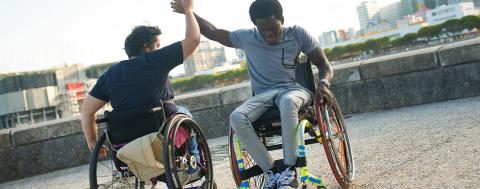
VOLTING: from reduced mobility to augmented and emotional mobility
In partnership with dancers and choreographers, the Versailles Systems Engineering Laboratory (LISV - Université Paris-Saclay, UVSQ) has launched the VOLTING project. An initiative that aims to give people with disabilities the ability to regain a certain freedom of movement and enjoy the pleasure of dance using an innovative wheelchair.
The VOLTING project, led by Éric Monacelli, a researcher at the Versailles Systems Engineering Laboratory (LISV) and president of the Resource and innovation centre for mobility and disability (CEREMH), is exploring how the wheelchair can aid dance. The name refers to the "volte", the lively and twirling Provençal dance, the electrical unit, the "volt" and movement with the suffix "ing". The project wants to offer users the opportunity to experience augmented mobility, in terms of both movement and emotion. Still in development, the technology has significant potential for sportspeople, dancers and individuals with reduced mobility. Currently funded by SATT Paris-Saclay as part of the Poc Up Program 2021 call for applications, the project also won the Université Paris-Saclay Poc in Labs call for proposals and that of the Arts-Sciences "Phare" of the Diagonale Paris-Saclay in 2019.
An interactive robotics project rooted in a motor laboratory
The VOLTING project was born at the heart of the LISV and is deeply rooted in the laboratory's DNA. The LISV develops its multidisciplinary research activities around three main areas, interactive robotics, advanced systems and nanosystems, and intelligent mechatronic systems. Through their many national and international industrial partnerships, its scientists combine research activities with industrial and societal production.
VOLTING is part of the laboratory's "Interactive Robotics" area, which explores the design of personal assistance systems. Several important innovations have resulted from this research team including the Gyrolift, a sit-to-stand electric wheelchair project, which led to the creation of a start-up in 2017. The result of a project between LISV and the Handipode association, this locomotion device combines a wheelchair and a two-wheel gyropod, giving people the ability to stand up. Eric Monacelli remembers how it came about: "In 2011, the father of a child with reduced mobility asked me if his son could use a Segway gyropod to get around... That's when we came up with the idea of a two-wheeled, sit-to-stand wheelchair." Another innovation developed by the LISV and CEREMH, BECAPE, is a driving test simulator, adapted to the elderly or people with reduced mobility and already distributed across a dozen rehabilitation centres.
So, this is not Eric Monacelli's team's first attempt to tackle such issues and VOLTING takes advantage of all their experience. "Our objective is to promote mobility for all, through the partnership unique in France between research at the LISV and the mobility school at CEREMH."
Innovating for freedom of movement
Whether they use a conventional or electric wheelchair, wheelchair users have limited capabilities and freedom of movement. With a conventional wheelchair, there are often just two possibilities: to move forwards (or backwards) and turn, and this on a horizontal plane. Users also need to use their arms to propel the chair.
The technologies and innovations developed as part of the VOLTING project are changing these conventions. Firstly, through a robotic structure equipped with several aids, the objective is for the person to experience a new, adapted and augmented mobility, by tilting the balance of the chair. Secondly, the addition of sensors placed on the person's body allows them to control and guide the chair without contact, based on the movement of the upper body, thus freeing up their arms and torso.
Scientists and artists working together: the highlight of the show
In addition to augmented mobility, the electric wheelchair developed by the VOLTING project offers an emotional boost. The person experiences a gliding sensation. "We allow the person to dance. Certain upper body movements allow them to create a dance while they can use others to give commands. The idea is to propose a new body language, to relearn balance ", explains Eric Monacelli. This wheelchair is the result of continuous interactions between researchers, dancers and choreographers. Artists were quick to experiment with the prototype developed and share their feelings and delight at this gliding sensation.
This collaborative work has resulted in a first show, À la verticale de soi (Vertical to oneself), performed by the company Mobilis Immobilis as part of the Imago Festival in Créteil in 2021 and at Plaisir in 2023. Other acts will follow in collaboration with partner universities. One of the ambitions of the VOLTING project is to create a performance involving both able-bodied and non-able-bodied individuals for the 2024 Olympic and Paralympic Games in Paris.
There are many other applications for the VOLTING wheelchair beyond this highly-inclusive artistic initiative. It can be used by people with disabilities or the elderly, and can be applied to sports or leisure activities. It is also intended as a rehabilitation tool for adapted physical activity and well-being. For now, the project is open to partnerships for distributing and marketing the product.
References:
Callupe, J., et al. Volting, a novel dancing wheelchair with augmented mobility: mechanical design. In Proceedings of the 2023 8th International Conference on Control and Robotics Engineering (2023).
Callupe, J., et al. WISP, Wearable Inertial Sensor for Online Wheelchair Propulsion Detection. Journal Sensors, 22, 4221 (2022).
